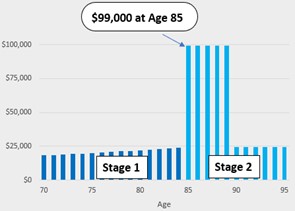Traditional planning for the cost of long-term care (LTC) doesn’t reflect the realities of what the costs are and where they’ll be paid from.
We’re living longer in retirement, and more of us want to age in place rather than sell the family home. A recent policy paper by AARP listed the goals of the age-in-place population:
- Ensure access to affordable, high-quality long-term services and supports (LTSS) that maximizes the dignity, independence, and protection of older adults
- Create age-friendly, livable communities that enable people to age in place, and continue as engaged members of their communities
- Support family caregivers
- Provide ample opportunities to generate, save, and preserve financial resources
Those goals all seem reasonable and smart. Our focus is around # 4 — and about planning to preserve resources while meeting retiree objectives.
Let’s start with costs.

How much do boomers need to pay expected LTC costs?
Americans incur more than $400 billion in LTTS costs every year. People over 65 make up the bulk of those who need care at a nursing facility, and a larger percentage of those who receive in-home care to assist with daily activities. Home care can cost about $62,000 a year, while care in a facility could be between $110,000 to $125,000. Here’s a projection of average costs considering the duration of these costs for male, female and a couple.

At some point, what you are required to pay for long-term healthcare may outstrip your bank and investment accounts and force you to dip into your hard-earned retirement savings. As you can see, the average cost for private room in a nursing home for a couple can be as much as $750,000.
The probability of incurring at least a portion of these costs is 70%, and therefore you need to plan ahead to ensure your financial resources are available when you need them and in a way that you can easily access.
How boomers plan to pay for long-term care
We have options, including some provided by the government, but in many cases, they require compromises in how to spend our money, or decisions about our lifestyles we would rather not make. From a study about 10 years old, the four most popular options for funding LTC were:
- Use personal savings
- Purchase private long-term care policy
- Spend down savings and qualify for Medicaid
- Sell home and use proceeds
And another group hadn’t even thought about it.
While I’m sure the planning has changed in the interim, I consider these options pretty challenging and in some cases life-changing. More recent studies agree that purchasing long-term care at the boomer’s current age is quite expensive. And with such a large percentage of the population wanting to age in place (a recent AARP survey puts it at more than 75% of adults over 50), selling your home is less appealing,
What is Sally going to do?
Sally, a 70-year-old woman who stands in as our example retiree, is now focused on this issue, and she is wondering about next steps, even with her $1.5 million in retirement savings and $1 million in equity in her home. Sally has done a good job using savings within a plan to meet her retirement goals of income, liquidity and legacy. Now she wants to explore how to address the expense of long-term care within or in addition to that plan.
The thought of spending on average another $375,000 is pretty daunting. Here are some options she thought about.
- Set aside investments so she can pay for LTC through her personal savings. That would require her to spend less, impacting her lifestyle even during the years that she feels great.
- Buy insurance to pay for long-term care. Like many consumers, Sally didn’t buy LTC insurance when she was younger. Buying it now will be much more expensive, and reduce funds for other expenses.
- Spend down savings to qualify for Medicaid. She has a lot of savings, so this is probably impractical.
- Stay in home and bring in help. Sally wants to age in place as long as she can. She is a little nervous about the costs for care along with home modifications – and the need to spend down savings at such a rapid rate.
Is there another option?
What about Home-Based Planning?
Since she’ll be aging-in-place she plans to live in her home for a long time and thus considers “home-based planning.” The specific option Sally considers is an approach called HomeEquity2Income (H2I), which combines (1) a home equity conversion mortgage (HECM), with (2) a deferred income annuity called QLAC. This combination provides both current cash flow and a line of credit through HECM to reduce or eliminate the necessity to spend her savings on long term care costs. See Things Change: Is It Time to Update Your Retirement Plan?
To Illustrate, here’s how H2I measures up for Sally when she used $200,000 from her rollover IRA savings to purchase QLAC, establishes a HECM line of credit of $330,000 against the equity in her home, and funds $75,000 per year in LTC costs from 85 to 89 only from H2I not from retirement savings.
Illustrated income from H2I

Illustrated legacy from H2I

In summary, this is what H2I does as measured against her personal objectives:
- Don’t run out of money — $20,000 additional income at start and continuing for life
- Grow income each year — 2% per year increase until age 85
- Lower income taxes — Income tax free until age 85
- Cover unfunded expenses — $75,000 per year in LTC costs from 85 to 89
- Leave a meaningful legacy — $1.3 million
What about her retirement savings and her plan for retirement income?
What about only drawing down from HECM?
While the coverage of $375,000 in LTC costs is pretty nice, couldn’t Sally have done the same thing without transferring $200,000 from her savings to purchase QLAC and simply draw down from HECM?
Here is our response:
- Sally got more than the LTC costs covered, as H2I also provided tax-favored income starting at $20,000 and continuing for life.
- Sally still passed along a legacy of over $1.3 million just from H2I.
With only, say, a $50,000 QLAC premium, her legacy at 85 would be reduced by more than half, and her liquidity would be wiped out at age 90. With no QLAC, her legacy is reduced by 75% and liquidity again is gone by age 90. What the chart below shows is that within the statutory limits the maximum funding of QLAC makes sense.

Making up Difference in Her Retirement Income Plan
And what about the transfer of $200,000 from her Rollover IRA savings? While the analysis requires you to take hard look on what Sally is doing with her retirement savings, here are a few points to consider:
- She’s deferring taxable RMDs to age 85 — and creating tax-free income from HECM.
- With the substitution of immediate income annuities for a portion of her fixed income portfolio, she can replicate or exceed her original income even with the $200,000 outflow
- With greater safe income she can increase her allocation to equities.
Conclusions for boomers who want to age in place
- LTC insurance purchased by boomers is costly and, where possible, should be used to fund “catastrophic” large amount LTC costs
- There will be other costs for age-in-place boomers beyond care-related payments.
- Minimize drain on retirement savings to cover LTC costs, unless you’re OK going on Medicaid.
We’ve taken you through the steps to address the costs of long-term care with a H2I plan, based on your own assets and needs. Visit Go2Income Personal Planning to start a plan risk-free. One of our analysts can help you make adjustments as you build a plan that gives you lifetime income, greater liquidity — and a clear path to paying long-term care costs.